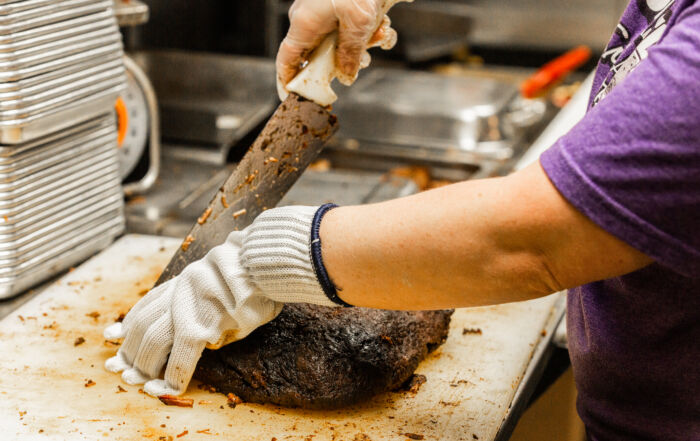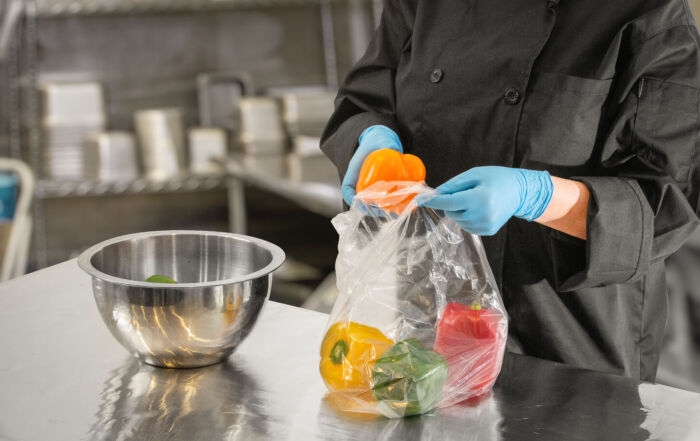Cross Contamination and the Surfaces that go Unnoticed
In October, I ran across a new research study published in the Journal of Food Protection in early-September. The article explored cross contamination in consumer kitchens during meal preparation. One of the authors was a previous SafeBites presenter, Dr. Ellen Shumaker, at North Carolina State University. Although the setting was consumer kitchens and not the commercial kitchen many of you deal with daily, the findings were very applicable to what we often see in the foodservice setting.
The study invited 371 consumers into consumer kitchens to prepare a menu consisting of a ready -to-eat vegetable salad and ground turkey patties. What consumers did not know was the ground turkey was inoculated with a non-pathogenic tracer organism, which allowed researchers to track cross contamination throughout the kitchen. When beginning the study, consumers believed they were simply trying new recipes, thus they were not aware of the food safety research being conducted. At the conclusion of the meal preparation, consumers were informed of the purpose of the study and the researchers sampled specific areas of the kitchen to determine areas in which cross contamination had occurred.
The areas the researchers tested to determine if cross contamination had occurred included the counter, kitchen utensils, areas used for cleaning (such as the sink, dishcloth/sponge, faucet handle, and soap dispenses), the refrigerator handle, spice containers, and the trash can lid. Of all the areas explored, spice containers had a statistically higher concentration of their tracer organism than almost all the other areas – with the exception of the trash can lid and cutting boards. As the authors noted in their study, few studies have reported that spice containers were a common form of cross contamination. Perhaps this is why the study caught my eye in the first place.
…it is those smaller items that are used frequently throughout the day that may go unnoticed at the end of the shift …that can cause just as much of a cross contamination issue as the work surfaces and cutting boards.
I thought this was an interesting study and really made me think of the common everyday items in our kitchens that could pose a risk for cross contamination. For years, food safety training has included the common items that we must wash and sanitize appropriately and frequently – the work surfaces, cutting boards, knives, etc. However, it is those smaller items that are used frequently throughout the day that may go unnoticed at the end of the shift when our staff go about their normal cleaning and sanitizing duties that can cause just as much of a cross contamination issue as the work surfaces and cutting boards. The spice containers, the stainless-steel film and foil dispensers, label dispensers, and even the Bluetooth speakers that our staff bring into the kitchen or dish areas during their shift could all pose a significant risk if not properly cleaned and sanitized.
Before we get into the rush of the holiday season, take the time to critically analyze your employees’ habits as they go throughout their day. What are those items that we may need to include in our training that staff may overlook when cleaning and sanitizing? Once you discover what they are, discuss these with your staff in training and/or pre-shift meetings. Add them to your Standard Operating Procedures and be sure those small items in your kitchen don’t become a forgotten and overlooked item that becomes a big problem when it comes to cross contamination in your kitchen.
Later this month, we will be releasing our fourth and final SafeBites Webinar for the year, “A Foodservice Operators’ Guide to the Food Code”, presented by food safety specialist, Sara Kingland, who is recognized as a standardized food inspector. If you have any topics you’d like her to address, please reach out and let me know and we will be sure she includes it in her talk. Likewise, if you have any food safety questions, I’m are just a quick email away and am happy to help with whatever you might be wondering about. Risk Nothing.
READ MORE POSTS
Your Guide to Approved Food Safety Training Programs in 2025
Early in my foodservice career, I persuaded the owners of the restaurants I managed to [...]
Thanksgiving Food Safety: Separating Fact from Fiction
Most blogs that I write are geared toward the foodservice professional preparing food in commercial [...]
Preventing Norovirus in your Foodservice Operation
Norovirus is one of the leading causes of vomiting and diarrhea in the United States, [...]
Safe Handling of Leftovers in Foodservice Operations
In any foodservice operation, leftovers are inevitable. After managing a family-style restaurant, where all-you-can eat [...]










